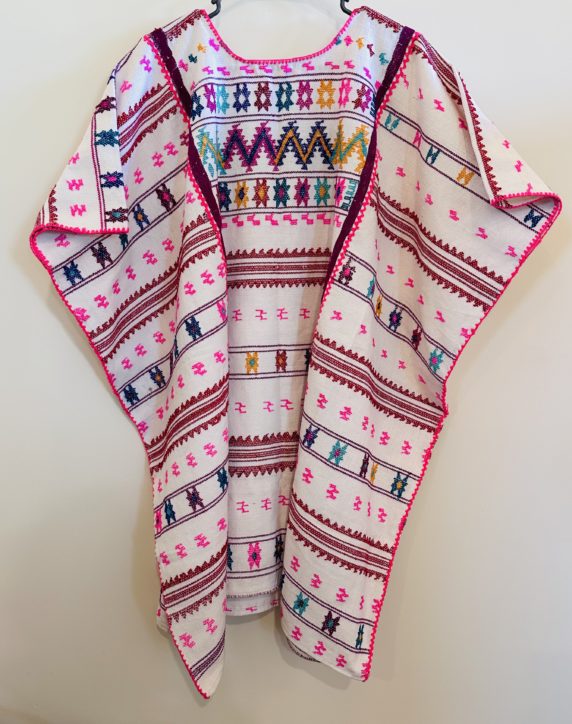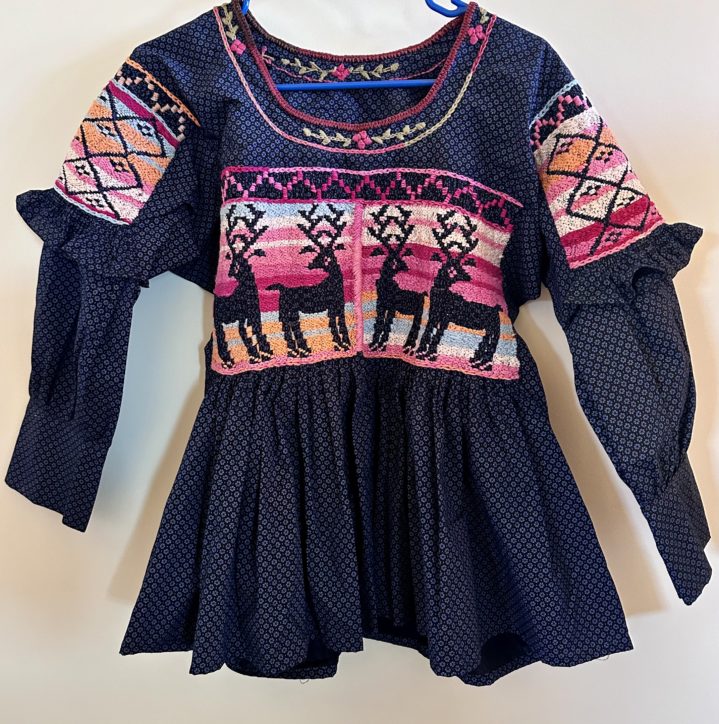In July 2007, when Andrea Donnelly, a textiles student, came to Teotitlan from NC State University to do a natural dyeing residency with Eric Chavez, I listened to their conversations and took notes. Erick talked about how few people are coming to their home in Teotitlan since the teacher’s strike, so he appreciated that Andrea came to study and workshop with him and his father Federico. Eric explained that he has experimented with cochineal and is able to get over 95 different shades ranging from dark purple to bright orange, reds, and pinks, by manipulating the Ph of the dye bath. The color intensity and shading depends on whether he uses lime juice or vinegar and the quanitity of cochineal. An acid solution will result in a brighter color, he says. Eric is experimenting, measuring the Ph of the dye bath, and recording recipes (chemical formulas). Another variable is the shade of natural wool a weaver chooses to dye. Brown, black, white, and beige wool will absorb dyes differently and add to the variation in color.
We estimate that only about 10% of the village weavers are actually using natural dyes because they are so expensive and labor intensive, and those who do usually estimate the ingredients each time they dye, much like our great-grandmothers used to cook — a pinch of this and a tad of that.
The way to create color using synthetic dyes is much simpler — one doesn’t need a mordant because there is sulfuric acid (toxic) already added to the dye mixture. In natural dyeing, Eric and Federico use alum and cream of tartar to “fix” the dyes. Ancient Zapotecs used only natural dyes from palnt materials. Eric has researched this and says that the written records that explained methods to extract dye from palnt materials were destroyed in the Spanish conquest. He wanted to preserve this part of his culture, so began experimenting using modern chemistry techniques.
In previous entries, I’ve talked about the toxicity of chemical dyes and their environmental impact. When a weaver dyes 20 lbs. of wool at one time, standing over the dye pot, breathing the vapors, not using a mask, this will cause itchy throat, watery eyes, and inflamed lungs. Respiratory problems are not uncommon. This is one reason why Eric wanted to learn more about natural dyes — to lower the health risks of his people.
As Eric continues, he explains that there are other natural options for mordants that come from the plants called tejute (Teh-hu-tay) and pericone, in addition to using alum and cream of tartar. There is an old Zapotec recipe for using tejute that is most effective. You chop the plant, add it to cochineal along with oak tree bark and then boil it for the dye bath. Pericone is used to make yellows, and results in the same coloration as the yellow one can extract from moss. These plants are almost extinct. The cooperative, Bii Dauu, runs an organic farm near the reservoir outside of Teotitlan and they are growing percone and tejute to reintroduce and preserve it.
When the Spaniards came to Mexico they hoped to find gold, but they discovered cochineal instead. The Spanish imported 70 tons of cochineal a year for sale on the world markets. Cochineal was used to dye the red coats of the British Army and the lipsticks made for Europe’s royalty. The cochineal bug has a short life span as a parasite on the prickly pear cactus. It is picked, dried, ground and then mixed with various ingredients to create many shades. Cochineal mixed with baking soda yields purple, with lime you get red or orange, with vinegar — orange, mixed with pomegranate seeds and skins yields green and beige.
Like this:
Like Loading...









